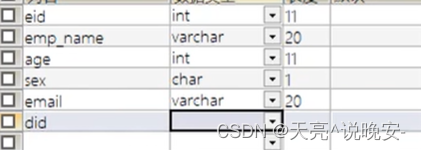提示:以下是本篇文章正文内容,下面案例可供参考
一、自定义映射resultMap
数据库:下划线

实体类:驼峰
public class Emp {
private Integer eid;
private String empName;
private Integer age;
private String sex;
private String email;
private Dept dept;
get,set,toString
}
1、resultMap处理字段和属性的映射关系
若字段名和实体类中的属性名不一致,但是字段名符合数据库的规则(使用_),实体类中的属性名符合Java的规则(使用驼峰)
此时也可通过以下两种方式处理字段名和实体类中的属性的映射关系
a>可以通过为字段起别名的方式,保证和实体类中的属性名保持一致
<!--List<Emp> getAllEmp();-->
<select id="getAllEmp" resultMap="empResultMap">
select eid,emp_name empName,age,sex,email from t_emp
</select>b>可以在MyBatis的核心配置文件中设置一个全局配置信息mapUnderscoreToCamelCase,可以在查询表中数据时,自动将_类型的字段名转换为驼峰
例如:字段名user_name,设置了mapUnderscoreToCamelCase,此时字段名就会转换为userName
<!--设置MyBatis的全局配置-->
在MyBatis-config文件
<settings>
<!--将_自动映射为驼峰,emp_name:empName-->
<setting name="mapUnderscoreToCamelCase" value="true"/>
<!--开启延迟加载-->
<setting name="lazyLoadingEnabled" value="true"/>
</settings>
<!--List<Emp> getAllEmp();-->
<select id="getAllEmp" resultMap="empResultMap">
select * from t_emp
</select>若字段名和实体类中的属性名不一致,则可以通过resultMap设置自定义映射
<!--
resultMap:设置自定义映射
属性:
id:表示自定义映射的唯一标识
type:查询的数据要映射的实体类的类型
子标签:
id:设置主键的映射关系
result:设置普通字段的映射关系
association:设置多对一的映射关系
collection:设置一对多的映射关系
属性:
property:设置映射关系中实体类中的属性名
column:设置映射关系中表中的字段名
-->
<resultMap id="empResultMap" type="Emp">
<id property="eid" column="eid"></id>
<result property="empName" column="emp_name"></result>
<result property="age" column="age"></result>
<result property="sex" column="sex"></result>
<result property="email" column="email"></result>
</resultMap>
<!--List<Emp> getAllEmp();-->
<select id="getAllEmp" resultMap="empResultMap">
select * from t_emp
</select>2、多对一映射处理
一个部门可以有多个员工
员工实体类
public class Emp {
private Integer eid;
private String empName;
private Integer age;
private String sex;
private String email;
private Dept dept;
get,set,toString方法
}
部门实体类
public class Dept {
private Integer did;
private String deptName;
get,set,toString方法
}
查询员工信息以及员工所对应的部门信息
- a>级联方式处理映射关系
<!--处理多对一映射关系方式一:级联属性赋值-->
<resultMap id="empAndDeptResultMapOne" type="Emp">
<id property="eid" column="eid"></id>
<result property="empName" column="emp_name"></result>
<result property="age" column="age"></result>
<result property="sex" column="sex"></result>
<result property="email" column="email"></result>
<result property="dept.did" column="did"></result>
<result property="dept.deptName" column="dept_name"></result>
</resultMap>
<select id="getEmpAndDept" resultMap="empAndDeptResultMapOne">
select * from t_emp left join t_dept on t_emp.did = t_dept .did where t_emp.eid = #{eid}
</select>- b>使用association处理映射关系
<resultMap id="empAndDeptResultMapTwo" type="Emp">
<id property="eid" column="eid"></id>
<result property="empName" column="emp_name"></result>
<result property="age" column="age"></result>
<result property="sex" column="sex"></result>
<result property="email" column="email"></result>
<!--
association:处理多对一的映射关系
property:需要处理多对的映射关系的属性名
javaType:该属性的类型
-->
<association property="dept" javaType="Dept">
<id property="did" column="did"></id>
<result property="deptName" column="dept_name"></result>
</association>
</resultMap>
<select id="getEmpAndDept" resultMap="empAndDeptResultMapTwo">
select * from t_emp left join t_dept on t_emp.did = t_dept .did where t_emp.eid = #{eid}
</select>- c>分步查询
1)查询员工信息
在EmpMapper
/**
* 通过分步查询查询员工以及员工所对应的部门信息
* 分步查询第一步:查询员工信息
*/
Emp getEmpAndDeptByStepOne(@Param("eid") Integer eid);<resultMap id="empAndDeptByStepResultMap" type="Emp">
<id property="eid" column="eid"></id>
<result property="empName" column="emp_name"></result>
<result property="age" column="age"></result>
<result property="sex" column="sex"></result>
<result property="email" column="email"></result>
<!--
select:设置分步查询的sql的唯一标识(namespace.SQLId或mapper接口的全类名.方法名)
column:设置分布查询的条件
fetchType:当开启了全局的延迟加载之后,可通过此属性手动控制延迟加载的效果
fetchType="lazy|eager":lazy表示延迟加载,eager表示立即加载
-->
<association property="dept"
select="com.atguigu.mybatis.mapper.DeptMapper.getEmpAndDeptByStepTwo"
column="did"
fetchType="eager"></association>
</resultMap>
<!--Emp getEmpAndDeptByStepOne(@Param("eid") Integer eid);-->
<select id="getEmpAndDeptByStepOne" resultMap="empAndDeptByStepResultMap">
select * from t_emp where eid = #{eid}
</select>2)根据员工所对应的部门id查询部门信息
在DeptMapper
/**
* 通过分步查询查询员工以及员工所对应的部门信息
* 分步查询第二步:通过did查询员工所对应的部门
*/
Dept getEmpAndDeptByStepTwo(@Param("did") Integer did); <!--Dept getEmpAndDeptByStepTwo(@Param("did") Integer did);-->
<select id="getEmpAndDeptByStepTwo" resultType="Dept">
select * from t_dept where did = #{did}
</select>分步查询的优点:可以实现延迟加载,但是必须在核心配置文件中设置全局配置信息:
lazyLoadingEnabled:延迟加载的全局开关。当开启时,所有关联对象都会延迟加载
aggressiveLazyLoading:当开启时,任何方法的调用都会加载该对象的所有属性。 否则,每个属性会按需加载
此时就可以实现按需加载,获取的数据是什么,就只会执行相应的sql。此时可通过association和collection中的fetchType属性设置当前的分步查询是否使用延迟加载,fetchType=“lazy(延迟加载)|eager(立即加载)”
<!--设置MyBatis的全局配置-->
在MyBatis-config文件
<settings>
<!--将_自动映射为驼峰,emp_name:empName-->
<setting name="mapUnderscoreToCamelCase" value="true"/>
<!--开启延迟加载-->
<setting name="lazyLoadingEnabled" value="true"/>
</settings>3、一对多映射处理
实体类
一个部门可以有多个员工
员工实体类
public class Emp {
private Integer eid;
private String empName;
private Integer age;
private String sex;
private String email;
private Dept dept;
get,set,toString方法
}
部门实体类
public class Dept {
private Integer did;
private String deptName;
private List<Emp> emps;
get,set,toString方法
}
- a>collection
<resultMap id="deptAndEmpResultMap" type="Dept">
<id property="did" column="did"></id>
<result property="deptName" column="dept_name"></result>
<!--
collection:处理一对多的映射关系
ofType:表示该属性所对应的集合中存储数据的类型
-->
<collection property="emps" ofType="Emp">
<id property="eid" column="eid"></id>
<result property="empName" column="emp_name"></result>
<result property="age" column="age"></result>
<result property="sex" column="sex"></result>
<result property="email" column="email"></result>
</collection>
</resultMap>
<!--Dept getDeptAndEmp(@Param("did") Integer did);-->
<select id="getDeptAndEmp" resultMap="deptAndEmpResultMap">
select * from t_dept left join t_emp on t_dept.did = t_emp.did where t_dept.did = #{did}
</select>- b>分步查询
1)查询部门信息
在DeptMapper.java
/**
* 通过分步查询查询部门以及部门中所有的员工信息
* 分步查询第一步:查询部门信息
*/
Dept getDeptAndEmpByStepOne(@Param("did") Integer did);在DeptMapper.xml
<resultMap id="deptAndEmpByStepResultMap" type="Dept">
<id property="did" column="did"></id>
<result property="deptName" column="dept_name"></result>
<collection property="emps"
select="com.atguigu.mybatis.mapper.EmpMapper.getDeptAndEmpByStepTwo"
column="did" fetchType="eager"></collection>
</resultMap>
<!--Dept getDeptAndEmpByStepOne(@Param("did") Integer did);-->
<select id="getDeptAndEmpByStepOne" resultMap="deptAndEmpByStepResultMap">
select * from t_dept where did = #{did}
</select>2)根据部门id查询部门中的所有员工
在EmpMapper.java
/**
* 通过分步查询查询部门以及部门中所有的员工信息
* 分步查询第二步:根据did查询员工信息
*/
List<Emp> getDeptAndEmpByStepTwo(@Param("did") Integer did);
在EmpMapper.xml
<!--List<Emp> getDeptAndEmpByStepTwo(@Param("did") Integer did);-->
<select id="getDeptAndEmpByStepTwo" resultType="Emp">
select * from t_emp where did = #{did}
</select>




















 1298
1298











 被折叠的 条评论
为什么被折叠?
被折叠的 条评论
为什么被折叠?








